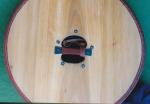(08-24-2023, 04:42 AM)Sean Manning Wrote: In cultures where iron was not very scarce such as La Tene C and Early Anglo-Saxon England, the old grips were often reinforced with a sheet of iron. My shield uses 1.5 mm or so mild steel. The iron sticks above the back of the shield but the underlying wood did not until the introduction of the new grip. On original shield handles, sometimes the iron wraps around the wood at the very center of the shield, but I chose a flat reinforcement because I don't have an anvil and blacksmith's tongs to bend the iron.
Because the iron object from Myklebost is shaped like a trough, I think it would have worked nicely as a reinforcement for the new grip as seen on some medieval bucklers and ancient shields with the old grip. The wood would fit inside and still stick out from the back of the shield for half of more of the diameter of the shield. Because I'm not an expert on the few surviving shield handles from the Viking Age, I'm not sure whether the type reinforced along their length with iron or bronze should be classed differently. It looks like the anonymous Project Forlog post with the typology of metal fittings for handles is https://sagy.vikingove.cz/en/decorated-s...ss-norway/
Anglo Saxon metal reinforcing on grips are often just flat plate so it isn't necesary to go the whole hog with a "winged" version unless your making a specific replica:
This one is pretty old I made it in the 90s and based on Westgarth Gardens or Moningthorpe ASC examples many of which are quite similar, dia is about 60cm, poplar board 3 planks glued edge to edge 10-6mm thick, calfhide cover about 1.5-2mm stitched to the board round the edge.



"
I'm not sure whether the type reinforced along their length with iron or bronze should be classed differently"
I would agree... but I'm not trying to do that, only to differentiate between what has gone before and the "new" metal reiforced style grips of the Viking age.
Since the Viking metal D shaped grip reinforcement is 1-1.5cm deep at the grip, there must be something more to it, otherwise it wouldn't be much of a grip.
A wooden component that no longer survives must have been present, extending into the hand hole either as part of it or an additional component, not unlike what has gone before but raised at the back to some degree, in a similar fashion to germanic grips but more so.
By comparison the Illerup shield grips are typically 20-25mm deep in their current state, if the same measurements are used for the Viking reinforced grips then in most cases the wooden component of the grip would extend through the hand hole and beyond the front face of the shield:

However the "new" long grip seems to be based on just the short Trellerborg example and possibly one other shield with very long boss rivets from Birka Bj 727, which suggests either a very thick shield or a raised grip.
Gokstad appears to be unreliable as far as this type is concerned, its likely all the grips would have been broken into pieces as the shields were bent over, so the rods acting as grips on the reconstructions are unlikely to be the real thing.
In the recent article on the
Gokstad shields the author identifys a grip extension, however the item would if full size be too long by far for any of the size estimates given for the shields at 90-94cm wide, as its 49.7cm long
without the grip and second half...
49.7cm + 8cm minimum + 49.7cm = 107.4cm minimum shield diameter since you still have to add some for the rim.
![[Image: two-shield-constructions.jpg]](https://www.bookandsword.com/wp-content/uploads/2023/08/two-shield-constructions.jpg)
![[Image: two-shield-constructions.jpg]](https://www.bookandsword.com/wp-content/uploads/2023/08/two-shield-constructions.jpg)






